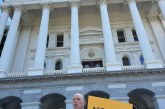

By David M. Greenwald
Executive Editor
YIMBY California in a tweet earlier this week, noted that there is a basic illogic of current migration patterns. During a time of global warming, people are actually relocating from cool coast cities in California to hot, inexpensive inland cities elsewhere.
They noted temperatures on Wednesday for instance:
“Today’s highs in expensive, anti-housing coastal California cities:”
Santa Monica – 78°
San Francisco – 65°
La Jolla – 75°
At the same time, “Today’s highs in the inexpensive cities that people priced out of coastal CA move to:”
Phoenix – 109°
Las Vegas – 104°
Houston – 101°
Dallas – 104°
This note follows an article in the LA Times that finds that cities like Fresno—another inland, hot climate city—are feeling “the repercussions of L.A., Bay Area housing crisis.”
Columnist Alicia Olivarez notes, “As skyrocketing housing costs in Los Angeles and the Bay Area push more people into outlying regions, those places have increasingly experienced the same pressures.
“Communities such as Fresno, once known as a relatively affordable oasis in a costly state, are the newest epicenters of California’s housing crisis. One study found that Fresno endured the fastest rent growth of any major city nationwide in 2021, 28%.”
Along with increase in rent growth, “The Fresno region recently reported a nearly 16% increase in its unhoused population over the previous two years even though the city already had a higher rate of unsheltered homelessness than any other major urban center nationwide.”
Olivarez notes, “Although a majority of its households pay rent, Fresno is one of only two major cities in California without rent control, the best immediate defense against rapidly rising rents and displacement. That leaves its residents more vulnerable to escalating housing costs than much smaller cities in Southern California and across the state.”
She noted that SB 567 from Senator Durazo “would protect more tenants by stopping landlords from finding loopholes around the very few existing tenant protection policies and strengthening enforcement.”
More importantly, she notes, “failing to address the housing crisis in Southern California and the Bay Area has exported the hardship to the Central Valley and beyond.”
That is a key point.
Another key point syncs up with the observation from California YIMBY, namely that higher home prices in relatively cool climates in California coastal cities are driving people out of those cool climates and into warmer climates.
Not only is that going to put more people in harm’s way of potential deadly heat, but it is going to put strains on GHG emissions as more people are forced to locate in environments that require at least partial air conditioning during peak months.
This is a point raised by the Urban Institute in a November 2022 article: “How Cities Can Tackle Both the Affordable Housing and Climate Crises.”
They note, “The affordable housing and climate crises are closely intertwined” as, “The lack of affordable housing in many cities forces households into suburbs, exurbs, and areas at higher risk of wildfires, floods, extreme heat, and other hazards.”
We have seen the impact of wildfire this week in places that do not normally experience it. But forcing people into areas that have more risk of fire is another impact of housing unaffordability.
The Urban Institute notes that “the increasing frequency and severity of extreme weather events—driven by climate change—exacerbate the housing crisis by reducing the supply of affordable housing and increasing housing and related costs. In 2021 alone, 1 in 10 US homes—more than 14 million—was damaged by disasters.”
That’s another point that we don’t think about—damage to housing and inability to repair increases the severity of a housing crisis.
“These dual crises are particularly acute for people with low incomes and people of color, who are both disproportionately cost burdened and more vulnerable to the effects of climate change,” they add.
Dana Bourland in an interview with Urban Institute notes, “Our housing system produces a reality in which residents who work 40 hours a week for minimum wage cannot afford a two-bedroom apartment in any US county.”
The housing stock alone “is a major contributor to climate change” she points out, as “residential buildings account for 20 percent (PDF) of greenhouse gas emissions. And most of this housing is “gray housing,” which serves the immediate, necessary function of providing shelter but is often energy inefficient and adjacent to sites of environmental injustice (PDF), exposing residents to health hazards, including air and water pollution.”
She added, “Gray housing is unhealthy for the planet and threatens residents’ physical and financial health.”
But more than that, this housing inequity forces people to drive to work, adding GHG and VMT. And it, as noted above, forces people into more environmentally vulnerable regions.
Much has been made about the projected populations of California declining. We have pushed back on some, arguing that the cause of that decline is largely housing costs. What this data and research show, however, is that the market is actually working against future trends.
Climate change should be pushing people toward cooler climates, but housing cost is doing the reverse.
There is nothing irreversible about the trend, but if we continue to wait, there are things irreversible about climate change and its impact.







I got my first PG&E bill yesterday since solar was installed on my roof. My house actually produced 100 more KWh than we used for the month. So living inland means more heat but also more sunny days. So as for climate change it could be more advantageous to have people migrating towards hotter areas if solar can be more abundant. I bought my solar but anyone can get free solar installed if they sign a lease.
Now on the other hand since most people heat their homes with gas maybe living on the coast where it is cooler may actually lead to more climate consequences in the long run.
But yes, it would depend on most inlanders going to solar. But if you look around that seems to be where we’re headed.
The recent NEM 3.0 decision out of the Public Utilities Commission is doing its best to kill rooftop solar at the behest of PG&E. Installations are already down 40%. As for winter heating, the temperatures are colder in the Central Valley and heating loads are higher.
Ron O, so you’re point is that we should end building housing anywhere in the Central Valley? Yet more unrealistic fantasies. Davis going alone will make no difference in this trend because developments will go into Woodland, Roseville or Elk Grove instead, but those will be less environmentally friendly. For example, none of those places incentivize all-electric homes.
I believe that solar panels are required on all new houses (statewide) at this point.
But I agree with you, that Woodland, Roseville and Elk Grove should enact something like Measure J. And that the state should eliminate all RHNA targets for all communities in the valley.
But I was glad to hear that you decided to keep a “second car”, to prevent a new owner from driving it even more than you do. I’d suggest that you get at least 100 more cars, to have an even more-positive impact.
I got in under the wire for NEM 2.0. I think part of why there’s a 40% decline right now is because people did like me and beat the deadline. NEM 3.0 forces people to have to buy a battery in addition to their solar thereby increasing the costs. But with time I’m sure sales and installations will pick up again.
We definitely should not be building housing to accommodate commuters… I think that part I agree with. Its also part of why I think we should stop widening highways… At some point, providing a relief valve to coastal housing issues isn’t in our larger best interest.
Thats why my preference for the local housing we DO build to be transit-connected medium density housing with only one parking spot per dwelling unit… Such housing would only really appeal to the local workers we have displaced from Davis… who are currently driving too much because they cant find a spot in town. It would be a lot less attractive to people who are tempted to live here and commute to the bay every day.
That is THE way to have housing that splits the difference on that front.
I clicked on the tweet and had to laugh at the first reply which shows how ridiculous a lot of this is where people think they have the right to housing wherever they want. This response was gold:
I tried to locate the California YIMBY donor list to see who is backing them. I couldn’t uncover anything but I did find this article from a year ago. I wonder if there is a more current accounting of their donors?
Ah yes, shoot the messenger…
Don’t you think who’s funding these organizations says a lot about the organization itself?
Would you say the same thing if oil company money was funding a non-profit that was advocating against net-zero climate policies?
https://www.opendemocracy.net/en/dark-money-investigations/global-warming-policy-foundation-net-zero-watch-koch-brothers/
“Don’t you think who’s funding these organizations says a lot about the organization itself?”
Maybe, but why is it relevant to this article/ discussion?
First off, there’s no “maybe” about it. YIMBY groups are funded by business interests who have an interest in ensuring continued growth.
Does the “reason” that it’s relevant really need to be explained to you?
The issue here was that the only reference to CA YIMBY was the temperatures. I didn’t check to make sure the exact figures were right, but it passed the smell test.
Second, you actually don’t really understand how this stuff work. First of all, YIMBY favors housing regardless of who is giving them money. Second, Keith referenced an article that YIMBY found Real Estate a less reliable partner than Tech interests. That makes sense because while developer interests get a bad rap, for the most part they are less interested in the housing crisis than in pushing their projects and there is at least some evidence that individually Real Estate developer benefit from the housing crisis because it pushes up their land value and thus their profit margin whereas Tech is worried to some extent that their employees are priced out of the housing market.
What “figures” are you referring to?
CA YIMBY doesn’t care about climate change. If they did, they wouldn’t be pushing for housing in the valley.
YIMBY organizations don’t fully disclose who is supporting them in the first place. It is true that the tech industry (which is interested in continuous growth) has been one of their major sponsors.
Here’s another “YIMBY-type” organization that is suing cities, which is sponsored (and I believe created by) by the real estate industry:
https://www.caforhomes.org/
NIMBYs are fueled by selfishness, elitism or any other arguments they can think of. Developers are interested in making money as our capitalistic system dictates. Brixmor is in it for the money. Would you rather convert to a system of socialism or communism?
As someone involved in the local “Yimby” group, I can tell you first hand: Developers are not huge fans of us.
Why? Because we are not out for the developer’s bottom line. Everyone involved in sustainable growth yolo, for example are involved because they feel the housing shortage is hurting our community and the planet… many of us see housing as a right and that the lack of housing is an injustice.
Developers want to make money, its literally their business to make money developing land… its right in the name.
But housing activists ask these developers do do things that they don’t absolutely want to do: Build affordable housing, build environmentally responsible housing engage with the community for long term planning. I can tell you from FIRST HAND, they are very reticent to meet with us and only do it begrudgingly.
Look at me as a case in point… Im a director in the local YIMBY group, and I am vocally AGAINST the current peripheral development projects in their current form.
Now… I want those properties developed… for sure… but developed in a more economically, socially and environmentally responsible way. Im telling them to go back to the drawing boards and give us something better… They do NOT like me very much… Im a pain in the @$$ to them.
S0 writing off the comments of someone who identifies as a YIMBY because you think they are just a shill for the developer is completely incorrect. You don’t have to be getting paid by a developer to understand just how bad our housing crisis is and want to do something about it.
If that was the only way the world worked, you would have to be asking yourself just how Greenpeace gets paid off by the whales.
True – Folks are moving from places like San Francisco (where the population has dropped by more than 6%) to places like Davis/Sacramento.
Davis can “do its part” by not building another stick of housing to accommodate this irresponsible trend. 🙂
Ron wants Davis to defy state law AND go against its own interests.
Apparently, the state wants to exacerbate the problem featured in your article.
David, with very clear data that building new housing costs municipal jurisdictions more to provide services to the residences and residents than they get in recurring revenue from those residences, how is avoiding greater budgetary shortfalls/deficits “going against its (Davis’) own interests”?
Yes, if you think about things along a uni-dimensional line, then you will reach that conclusion.
What line should I be thinking on? The building more $900,000 homes line?
Finances are anything but unidimensional. Decisions to digs deeper hole are anything but unidimensional. Failure to build $500,000 homes is anything but unidimensional.
Haven’t existing residents created the budgetary deficits in the first place Matt? The answer to that issue is to tax current residents more or allow more commercial development. To my knowledge neighboring cities aren’t incurring deficits.
Walter, if you go to the Srong Towns website (see https://www.strongtowns.org/journal/2020/8/28/the-growth-ponzi-scheme-a-crash-course
) you will find that the fiscal problems exist in all 50 states, not just in Davis and California. They are worse in California because of Prop 13, but as Winston Churchill once said, “Madam, we’ve already established what you are. Now we are haggling about the price.”
I don’t think that piece answered my question about existing residents dragging down Davis’ budget Matt. It is really an issue of common sense. Non existent residents have no current effect on our city’s fiscal picture, but current residents definitely do. What are the budgets like in Woodland and West Sacramento specifically? That organization sounds suspiciously like a NIMBY group.
Fiscal health dashboard for California cities. (Neither Davis nor Woodland appear to be on this list.)
https://www.auditor.ca.gov/local_high_risk/dashboard-csa
You can push back all you want, but the data doesn’t match what you claim.
What the data actually shows is that deaths will outnumber births – more than enough to account for a slight increase in migration into the state.
And unlike migration trends, deaths for an aging population are a certainty.
From PPIC: “California is in unprecedented demographic territory, one in which population declines characterize the state. Lower levels of international migration, declining birth rates, and increases in deaths all play a role. But the primary driver of the state’s population loss over the past few years has been California residents moving to other states.”
And you’re missing a key point – yes birth rates have been declining since 1990, but we knew these trends in 2019 when the projections were for the state to increase in population to nearly 55 million.
What changed is not birth rates or death rates, but migration rates.
https://www.ppic.org/blog/californias-plunging-birth-rates/
Per the Department of Finance, declining births and increasing deaths is the main driver. In fact, net migration out of the state is projected to be relatively minimal and declining for 2024 to 2026, with net migration into the state again happening by 2027, reaching 50K/year by 2028, and remaining at similar levels through 2060.
On the other hand, while births are estimated to outnumber deaths in 2023 by about 98,000, by the year 2060 deaths are projected to outnumber births by about 118,000.
Five comment rule is in effect and is retroactive for this article.
Don’t some of the commenters here need to perhaps compromise in order to get significant housing built in Davis? It’s no wonder developers are reticent to meet with local YIMBY groups. You can continue to take your hardline stances or try some “give and take”.